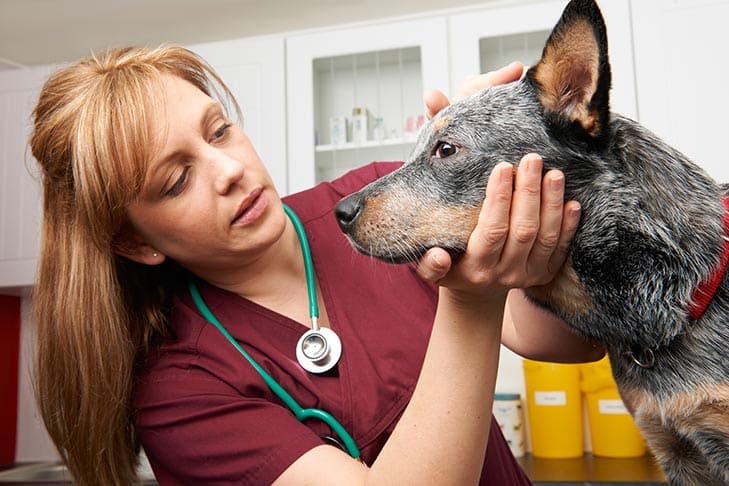Do you suspect your dog is having vision trouble? Perhaps they’re nervous in dimly lit spaces or bumping into things in unfamiliar environments.
Although many conditions could be responsible for your dog’s vision loss, one possible cause is progressive retinal atrophy, also known as PRA. This is a genetic disease of the retina in the eye. Read on to learn more about progressive retinal atrophy in dogs.
What Is Progressive Retinal Atrophy?
According to Dr. Jerry Klein, Chief Veterinary Officer for the American Kennel Club, “Progressive retinal atrophy is, as the name implies, a gradual progressive degeneration of the photoreceptor cells in the retina, causing gradual vision loss, eventually leading to blindness.”
To fully understand the condition, it helps to appreciate the anatomy of the retina. This is a layer at the back of the eye that contains light-detecting cells called photoreceptors. When photoreceptors sense light, they trigger nerve impulses that pass through the optic nerve to the brain, which creates and interprets the visual image. There are two main types of photoreceptors: rods and cones. Rods notice and track movement and work well in low light conditions, whereas cones detect color but need a lot of light to work. PRA impacts rods and cones.
Dr. Klein explains there are other causes of slowly developing blindness in dogs, such as glaucoma or cataracts, lens luxation, uveitis, or optic nerve tumors or disease. Therefore, it is important for your dog to get an accurate diagnosis. “Diagnosis of PRA requires a thorough retinal exam performed by a veterinarian who will often refer to a board-certified veterinary ophthalmologist. On some occasions, further diagnostics need to be performed to measure the electrical activity of the retina and evaluate possible development of other ocular conditions such as cataracts.”

What Age Does PRA Start in Dogs?
PRA’s progression is usually slow, with complete loss of vision taking place over a period of one to two years. But that can occur faster depending on the dog’s breed and the form of the disease. The condition can also strike dogs of almost any age. Dr. Klein says, “There are two basic types of PRA recognized in dogs. Early onset, also called retinal dysplasia, is usually found in young puppies around two to four months of age. Most PRA is seen in adult dogs from three to nine years of age.”
What Are the Symptoms of PRA?
Although PRA can lead to total blindness, the vision loss it causes is gradual. Therefore, in the beginning, PRA might be virtually undetectable by a dog’s owner. Dr. Klein advises what to watch out for. “Since PRA is not a painful condition, many owners may not notice early onset. At some point, most owners notice hesitancy when their dogs move or walk in dark areas or different surroundings. Some dogs may become more anxious in dark or shaded areas.”
In addition to night blindness and anxiety, you might see that your dog’s pupils are more dilated than usual. You might also notice that when light shines on your dog’s eyes, they reflect the light more strongly than they used to. If you see any of these symptoms, take your dog to the vet for a thorough examination.
What Is the Cause of Progressive Retinal Atrophy?
If your puppy has been diagnosed with retinal dysplasia, the early onset form of PRA, their photoreceptor cells will fail to develop properly as they mature, leading to blindness. In late onset PRA (which is more common), the photoreceptors develop normally when the dog is young, but then, later in life, they begin to deteriorate and atrophy. Dr. Klein explains, “Typically, the rod cells start to atrophy first, causing night blindness, and then the cone cells atrophy, leading to complete blindness.”
What Does It Mean if My Dog Is a Carrier of PRA?
PRA is an inherited disease, which means a dog is born with a defective gene. In some breeds, like Mastiffs and Bullmastiffs, PRA seems to be a dominant gene. That means a dog only needs to inherit one copy of the defective gene to develop the disease. In other breeds, like Samoyeds and Siberian Huskies, the gene seems to be linked with the sex of the dog and is found mainly in males.
However, in most cases of PRA, the dog needs to inherit the defective gene from both parents before developing the disease. This is known as an autosomal recessive pattern. That means dogs with only one copy of the gene for PRA won’t have PRA itself; they will carry the gene and can potentially pass it down to the next generation. These dogs are known as carriers. As Dr. Klein says, “Carriers may not have any signs of impaired vision but carry the gene, and when crossed with another carrier, they can produce affected individuals, other carriers, and possibly unaffected dogs.”

What Dog Breeds Are Most Likely to Have Progressive Retinal Atrophy?
PRA can occur in mixed breed dogs as well as purebred dogs. Some of the most commonly affected breeds include:
- Miniature Poodles
- Toy Poodles
- Cocker Spaniels
- Yorkshire Terriers
- Tibetan Spaniels
- Labrador Retrievers
- Miniature Long-Haired Dachshunds
- Bedlington Terriers
How Can You Help a Dog with PRA?
There is currently no effective treatment available for PRA, so the goal is to help an affected dog adjust and maintain a high quality of life. Don’t forget to continue to provide exercise and enrichment. Visually impaired dogs can even participate in many dog sports.
Dr. Klein suggests, “Trying to keep environmental consistency of a vision impaired dog is paramount for their safety and security. For the average family dog, blindness does not seem to be as significant an issue as it is in a person. Dogs rely heavily on other senses, such as smell and sound, and are able to move around fairly well in their home as long as furniture and other objects are not moved around.”








